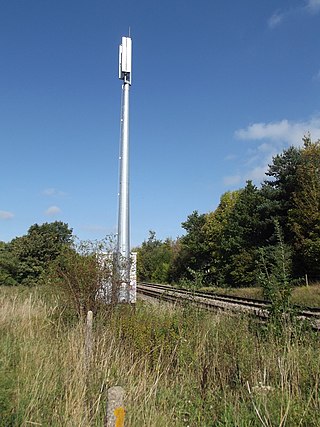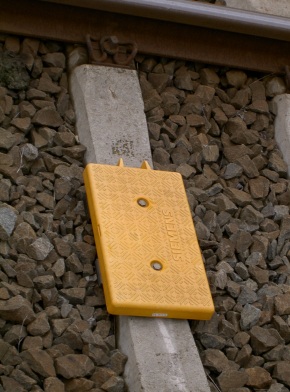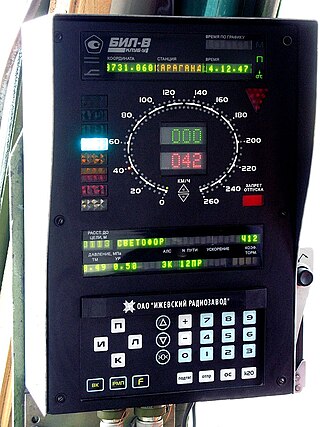Related Research Articles

The Bothnia Line is a high-speed railway line in northern Sweden. The 190 km (118 mi) long route, from Höga Kusten Airport, where it connects to the Ådalen Line, via Örnsköldsvik to Umeå, was opened in 2010 and trains are allowed to travel at speeds up to 250 km/h (155 mph). Although, no train with a higher top speed than 200 km/h (125 mph) uses the railway as of 2023.

A balise is an electronic beacon or transponder placed between the rails of a railway as part of an automatic train protection (ATP) system. The French word balise is used to distinguish these beacons from other kinds of beacons.

GSM-R, Global System for Mobile Communications – Railway or GSM-Railway is an international wireless communications standard for railway communication and applications.

Cab signaling is a railway safety system that communicates track status and condition information to the cab, crew compartment or driver's compartment of a locomotive, railcar or multiple unit. The information is continually updated giving an easy to read display to the train driver or engine driver.

The Cambrian Line, sometimes split into the Cambrian Main Line and Cambrian Coast Line for its branches, is a railway line that runs from Shrewsbury, England, westwards to Aberystwyth and Pwllheli in Wales. Passenger train services are operated by Transport for Wales Rail between the western terminals of Pwllheli, in Gwynedd, and Aberystwyth, in Ceredigion, and the eastern terminal at Shrewsbury, Shropshire, as part of the Wales & Borders franchise. The railway line is widely regarded as scenic, as it passes through the Cambrian Mountains in central Wales, and along the coast of Cardigan Bay in Snowdonia National Park.

Automatic train control (ATC) is a general class of train protection systems for railways that involves a speed control mechanism in response to external inputs. For example, a system could effect an emergency brake application if the driver does not react to a signal at danger. ATC systems tend to integrate various cab signalling technologies and they use more granular deceleration patterns in lieu of the rigid stops encountered with the older automatic train stop (ATS) technology. ATC can also be used with automatic train operation (ATO) and is usually considered to be the safety-critical part of a railway system.

The European Train Control System (ETCS) is a train protection system designed to replace the many incompatible systems used by European railways, and railways outside of Europe. ETCS is the signalling and control component of the European Rail Traffic Management System (ERTMS).

The Swedish Rail Administration was a Swedish State administrative authority which acted as owner on behalf of the State and maintained virtually all main railway lines in Sweden; except for short sidings for freight, heritage railways, the Stockholm Metro, local railways in the Stockholm area, and the tramways in Gothenburg, Norrköping and Stockholm. Its headquarters was located in Borlänge.
The European Rail Traffic Management System (ERTMS) is the system of standards for management and interoperation of signalling for railways by the European Union (EU). It is conducted by the European Union Agency for Railways (ERA) and is the organisational umbrella for the separately managed parts of

A Eurobalise is a specific type of a balise installed between the rails of a railway. Eurobalises are part of the European train control system (ETCS). The balises are pre-programmed and contain information that is read by train antennas. One of their many functions is to allow a train to determine its location.
Transmission balise-locomotive is a train protection system used in Belgium and on Hong Kong's East Rail line.
The Chinese Train Control System is a train control system used on railway lines in People's Republic of China. CTCS is similar to the European Train Control System (ETCS).
LOCOPROL has been a project to research the integration of satellite navigation into railway networks targeting low-density track lines. It is supposed to extend the ERTMS train protection systems. The partner project LOCOLOC was looking into cab signaling and speed control measures.
NSI-63 is a railway signaling system used for interlocking on the Norwegian railway network. It is based on relays and was developed by Norsk Signal Industri for the Norwegian State Railways (NSB) during the early 1960s. The systems are installed at railway stations and passing loops and consist of single relays built form drawings. The system is simple, robust and economical for smaller stations on single-track railways. The system makes use of track circuits for train detection.

KLUB is the name of the modern Russian train control systems. The abbreviation "КЛУБ" stands for "Комплексное локомотивное устройство безопасности", Integrated Train Protection System.

The West Dalarna Line, is a 129-kilometer (80 mi) long railway line between Malung and the Dala Line near Borlänge, in Dalarna County, Sweden. It has only freight traffic.
The European Rail Traffic Management System (ERTMS) is an initiative backed by the European Union to enhance cross-border interoperability and the procurement of signalling equipment by creating a single Europe-wide standard for train control and command systems.

The European Union Agency for Railways (ERA) is an agency of the European Union (EU) that sets mandatory requirements for European railways and manufacturers in the form of Technical Specifications for Interoperability (TSI), which apply to the Trans-European Rail system. The ERA publishes a document summarising the status of the TSIs. The ERA sets common safety targets, common safety methods and common safety indicators, following Directive 2004/49/EC and amendments. The ERA also hosts a number of databases, among which a register of remaining, applicable national rules.
The Advanced Train Management System is a train control system under development by Lockheed Martin for Australian Rail Track Corporation (ARTC). The ATMS uses Global Positioning System to locate and track the position of trains within the ARTC network. In particular the system will be deployed across the Nullabor Plain to connect the eastern states of Australia with Perth and Western Australia. ATMS has been proposed as a low cost functional equivalent to European Rail Traffic Management System.
Kavach is an automatic train protection (ATP) system indigenously developed by Indian Railways through Research Designs & Standards Organisation (RDSO). Initial development of Kavach started in 2012 under the name Train Collision Avoidance System (TCAS) and completed development in 2022.
References
- 1 2 3 4 "Banverket to pilot ERTMS Regional". Railway Gazette International . 1 July 2005. Archived from the original on 3 May 2012. Retrieved 23 May 2011.
- ↑ Mørten Søndergaard (24 April 2009). "Level 2 rolls out across the Danish network". Railway Gazette International . Archived from the original on 15 June 2011. Retrieved 23 May 2011.
- ↑ "ERTMS val av system för lågtrafikerade banor" (PDF) (in Swedish). Trafikverket. 2014-03-27. Retrieved 2018-01-04.
- ↑ Italy: Trials begin for ERTMS Level 3 Regional System – a new way of developing railway operations beyond the digitalisation of signalling UIC, 28 November 2017
- ↑ "Overall presentation of ERTMS ERTMS European Rail Transport Management System Regional". International Union of Railways. Archived from the original on 2011-08-16.
- ↑ "Yet more ERTMS challenges ahead". International Railway Journal. Archived from the original on 2010-05-02.